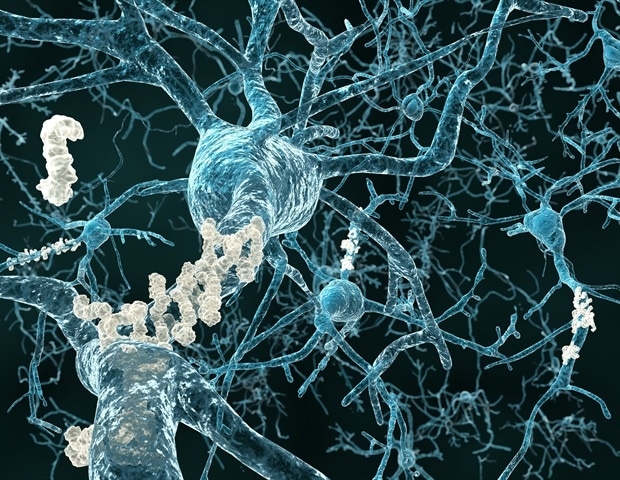
Benjamin Sumlin, PhD, a senior scientist at Washington College in St. Louis, blows into a tool designed by researchers on the college. The system — a breath take a look at that makes use of a biosensor — may turn into a device to be used in medical doctors’ places of work to rapidly diagnose folks contaminated with the virus that causes COVID-19.
Scientists at Washington College in St. Louis have developed a breath take a look at that rapidly identifies those that are contaminated with the virus that causes COVID-19. The system requires just one or two breaths and supplies ends in lower than a minute.
The research is offered on-line within the journal ACS Sensors. The identical group of researchers just lately printed a paper within the journal Nature Communications about an air monitor that they had constructed to detect airborne SARS-CoV-2 — the virus that causes COVID-19 — inside about 5 minutes in hospitals, colleges and different public locations.
The brand new research is a couple of breath take a look at that would turn into a device to be used in medical doctors’ places of work to rapidly diagnose folks contaminated with the virus. If and when new strains of COVID-19 or different airborne pathogenic ailments come up, such gadgets additionally could possibly be used to display folks at public occasions. The researchers stated the breath take a look at additionally has potential to assist forestall outbreaks in conditions the place many individuals stay or work together in shut quarters — for instance aboard ships, in nursing houses, in residence halls at schools and universities or on navy bases.
“With this take a look at, there aren’t any nasal swabs and no ready quarter-hour for outcomes, as with residence assessments,” stated co-corresponding writer Rajan Ok. Chakrabarty, PhD, the Harold D. Jolley Profession Improvement Affiliate Professor of Vitality, Atmosphere & Chemical Engineering on the McKelvey College of Engineering. “An individual merely blows right into a tube within the system, and an electrochemical biosensor detects whether or not the virus is there. Outcomes can be found in a couple of minute.”
The biosensor used within the system was tailored from an Alzheimer’s disease-related know-how developed by scientists at Washington College College of Drugs in St. Louis to detect amyloid beta and different Alzheimer’s disease-related proteins within the brains of mice. The College of Drugs’s John R. Cirrito, PhD, a professor of neurology, and Carla M. Yuede, PhD, an affiliate professor of — each additionally co-corresponding authors on the research — used a nanobody, an antibody from llamas, to detect the virus that causes COVID-19.
Chakrabarty and Cirrito stated the breath take a look at could possibly be modified to concurrently detect different viruses, together with influenza and respiratory syncytial virus (RSV). In addition they consider they’ll develop a biodetector for any newly rising pathogen inside two weeks of receiving samples of it.
It’s kind of like a breathalyzer take a look at that an impaired driver could be given. And, for instance, if persons are in line to enter a hospital, a sports activities area or the White Home Scenario Room, 15-minute nasal swab assessments aren’t sensible, and PCR assessments take even longer. Plus, residence assessments are about 60% to 70% correct, and so they produce a whole lot of false negatives. This system can have diagnostic accuracy.”
John R. Cirrito, Professor, Neurology, Washington College College of Drugs
The researchers started engaged on the breath take a look at system — made with 3D printers — after receiving a grant from the Nationwide Institutes of Well being (NIH) in August 2020, throughout the first yr of the pandemic. Since receiving the grant, they’ve examined prototypes within the laboratory and within the Washington College Infectious Illnesses Scientific Analysis Unit. The group continues to check the system, to additional enhance its at detecting the virus in folks.
For the research, the analysis group examined COVID-positive people, every of whom exhaled into the system two, 4 or eight occasions. The breath take a look at produced no false negatives and gave correct reads after two breaths from every particular person examined. The scientific research is ongoing to check COVID-positive and -negative people to additional take a look at and optimize the system.
The researchers additionally discovered that the breath take a look at efficiently detected a number of completely different strains of SARS-CoV-2, together with the unique pressure and the omicron variant, and their scientific research are measuring energetic strains within the St. Louis space.
To conduct the breath take a look at, the researchers insert a straw into the system. A affected person blows into the straw, after which aerosols from the particular person’s breath acquire on a biosensor contained in the system. The system then is plugged right into a small machine that reads alerts from the biosensor, and in lower than a minute, the machine reveals a optimistic or unfavorable discovering of COVID-19.
Scientific research are persevering with, and the researchers quickly plan to make use of the system in clinics past Washington College’s Infectious Illnesses Scientific Analysis Unit. As well as, Y2X Life Sciences, a New York-based firm, has an unique choice to license the know-how. That firm has consulted with the analysis group from the start of the undertaking and throughout the system’s design levels to facilitate potential commercialization of the take a look at sooner or later.
Supply:
Journal reference:
Ghumra, D. P., et al. (2023) Fast Direct Detection of SARS-CoV-2 Aerosols in Exhaled Breath on the Level of Care. ACS Sensors. .